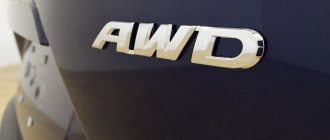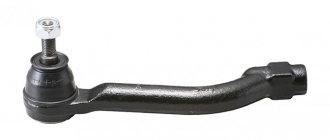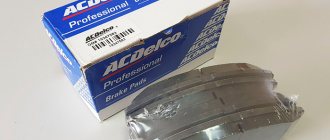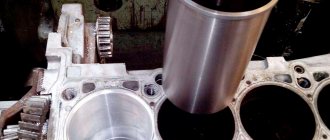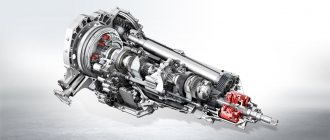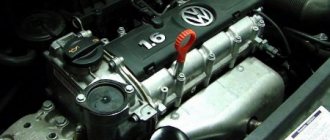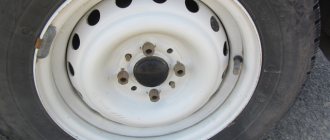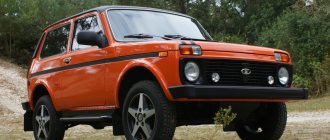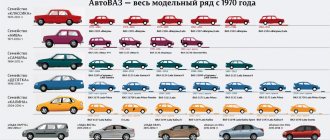The J segment, according to the European classification, includes cars of the SUV class - sport utility vehicle, that is, for sports and utilitarian purposes. This term is used for station wagon cars, predominantly equipped with an all-wheel drive system and distinguished by increased ground clearance.
BMW X3
The segment includes two categories of cars that differ in design - SUVs and crossovers. The difference between these two categories is the all-wheel drive design and the capabilities it has. If a crossover is a station wagon with increased cross-country ability, then an SUV is a full-fledged “all-terrain vehicle” with a comfortable interior and a number of design attributes necessary for city and highway driving (ABS, EBD, and so on).
Which class is higher D or C?
Economic Commission for Europe classification
| A: | Mini cars (European especially small class ; microcars) |
| B: | Small cars (European small class ; compact class ) |
| C : | Medium cars (European lower middle class ; “golf class ”) |
| D : | Larger cars (European middle class ; family class ) |
Signs of a Class J car
In recent years, the SUV segment has been developing at a rapid pace, so apart from a station wagon body and high ground clearance, a J segment car has no permanent features. If previously the body and components of an SUV were installed on a frame, which served as another distinguishing feature of this class, now even a car with very good cross-country ability, falling under the category of SUVs by all criteria, can have a monocoque body. This design helps reduce weight and save fuel.
Renault Duster
By the way, it was the appearance in the early eighties of the first SUVs with a monocoque body that contributed to the development of a new type of car, which is now commonly called a crossover.
An SUV differs from a minivan, first of all, in that the latter’s body structure, as a rule, has a clearly visible engine compartment that protrudes forward. At the same time, the interior layout can be exactly the same as that of a minivan—J-segment SUVs with a flat floor (without a transmission tunnel) and three rows of seats are often found.
J segment cars in the USSR and Russia
In 1957, the Moscow Automobile Plant produced the Moskvich-410/411/431 experimental car, an all-wheel drive modification of the Moskvich-402 production model. The car was built on a monocoque body, unlike GAZ models of an earlier period and SUVs produced around the world since the mid-twenties. Since Moskvich appeared long before the launch of the Cherokee XJ, perhaps it should be considered the world's first crossover.
SUVs in the USSR were also produced by the Ulyanovsk Automobile Plant (model 469 and others) and VAZ (Niva 2121 crossover). Nowadays, the production of updated versions of these SUVs continues.
Attempts to produce domestic SUVs were also made at other factories: for example, the Derways company produced the all-wheel drive Derways Cowboy (Derways 3131) of its own design in the city of Cherkessk. True, the car did not achieve much success in the market.
Tips for choosing a class
When choosing a car class, focus primarily on your budget, as well as personal preferences. You can usually find out what class a car belongs to on the official website of the brand. You can select several classes, make a table and write down several models, dividing the table into items about dimensions, engine power, and interior capacity.
The car class is more of a reference for quick comparison of models and better orientation in market segments. The lowest price is for class A+ cars, and the most expensive are luxury class cars. Accordingly, as the class increases, the cost of the car increases, and its technical characteristics also become better.
- Auto The Japanese are cooler than the Americans: the most reliable cars of 2022 have been named Consumer Reports has published a traditional rating of automobile brands.
- Author: Alexander Ponomarev
What is the car classification system based on?
Different countries around the world have different vehicle classification systems. They are used to classify a car or truck of a particular model. Each class has its own main parameter (or several parameters), which becomes the basis of the class. Most often, cars are classified according to the following parameters: dimensions, useful interior volume, engine displacement, vehicle weight, engine and its power, consumer market segment, and so on.
Pixabay
History of the development of the J segment
The predecessors of SUVs were small utility buses with a supporting frame (for example, the 1935 Chevrolet Carryall-Suburban - the ancestor of the modern Chevrolet Tahoe and Cadillac Escalade) and military vehicles (such as the legendary Willys MB, a US Army vehicle during World War II). Early representatives of long-wheelbase SUVs in the modern sense were the Soviet all-wheel drive GAZ-61 of 1938, the Willys Jeep Wagon of 1948, and the Land Rover Series II 109 of 1958.
The last 25 years for the J segment have been marked by increasing comfort and moving closer to road cars in terms of speed, agility and safety.
The term SUV appeared in the 80s. The concept of Sport Utility arose because at the beginning of the boom, SUVs were often used to transport sports equipment - skis, bicycles, etc. The prototype of modern crossovers was the Jeep Cherokee (XJ), an SUV with a monocoque body. Interestingly, even at that time the Cherokee advertising campaign was based on the advantages of an SUV over a traditional station wagon. This trend continues to this day: sales of crossovers are based on the advantages of all-wheel drive and increased ground clearance while maintaining body capacity.
Jeep Cherokee (XJ)
The last 25 years of development of the J segment have been marked by increasing the comfort of all-wheel drive vehicles and gradually bringing them closer to road cars in terms of speed, agility and safety. In this regard, the SUV's ground clearance gradually decreased, and in the Opel Mokka, for example, it is as low as in the average station wagon.
Opel Mokka
Modern fleet of J-class sailing yachts
The history of J-class yachts is inextricably linked with the America's Cup - the oldest international competition, one of the most famous and most prestigious regattas in the world. Initially British, for some time this regatta was predominantly local in nature, with yachts from the British Royal Yacht Squadron and occasionally from European yacht clubs taking part in it. The main prize - the challenge cup - was made in 1848 and was a jug without a day, on which the names of all the prize-winning yachts are engraved. The missing bottom was provided at the request of Queen Victoria, who did not want to see her subjects drinking from the prize vessel.
On August 22, 1851, a yacht from the United States took part in the regatta for the first time - the 30.86-meter schooner America, representing the New York Yacht Club. She finished first, a full 20 minutes ahead of 15 other yachts. To Queen Victoria's disappointment, the challenge cup left Britain for the United States of America. Over the next decades, until 1983, the New York Yacht Club stubbornly defended its title of winner, and the name “America's Cup” was assigned to the regatta.
Year after year, the regatta fleet was improved, the yachts grew in length and characteristics. In order to somehow stop this process and return sporting interest to the competition, in 1928 the Cup Committee decided to apply a single standard. This is how the “J” class of yachts was created, which made it possible to limit the size of the vessels participating in the race and, thereby, equalize their chances of winning. For the period from 1930 to 1937. 10 such yachts were built - six in the USA and four in England. These were the most progressive sports vessels of their time - large (up to 41 meters), incredibly beautiful, fast and extremely expensive.
With the outbreak of World War II, racing for the America's Cup ceased. From 1939 to 1943 Most of the J-class yachts were dismantled for scrap. Only Shamrock V (England, 1930), Endeavor (England, 1934) and Velsheda (England, 1933) escaped the sad fate. In post-war conditions, the organizers of the America's Cup were forced to completely abandon the expensive J-class and switch first to the cheaper 12-meter, then to the IACC. Since 2010, sailing catamarans with a rigid hull of the AC72 class (waterline length 22 meters, crew 11 people) began to participate in the regatta. On June 5, 2014, the organizers and applicant teams voted to use the smaller AC62 catamarans (waterline length 18.8 meters, crew 8 people) in the 2022 Cup. But already in March 2015, the organizing committee of the regatta proposed using an even smaller model of AC45 catamarans.
The J-class was reborn in 2000 with the creation of the J-class Yacht Association (JCA). Shamrock V, Endeavor and Velsheda were revived, Ranger was rebuilt, replicas of other yachts from the “ten” of the 30s appeared and continue to appear. Since 2011, J-class yachts have been systematically participating in regattas, the nearest of which will take place from June 23 to 27, 2015 in Falmouth, UK.
Today, the fleet of J-class yachts is represented by seven magnificent vessels:
1. Shamrock V (1930) Fleet Number: JK3 Owner (Original): Sir Thomas Lipton (Lipton Tea Corporation) Max. length (LOA): 36.58 meters Beam: 5.85 meters Draft: 4.81 meters Shipyard: Camper & Nicholson/Pendennis Shipyard Hull material: wood
2. Velsheda (1933) Fleet Number: JK7 Owner (Original): WL Stephenson Max. length (LOA): 39.4 meters Beam: 6.6 meters Draft: 4.57 meters Shipyard: Camper & Nicholson/Southampton Yacht Services Hull material: steel
3. Endeavor (1934) Fleet Number: JK4 Owner (Original): Sir TOM Sopwith Max. length (LOA): 39.56 meters Beam: 6.72 meters Draft: 4.76 meters Shipyard: Camper & Nicholson/Royal Huisman Hull material: steel
4. Ranger (2004; replica, original - 1937) Fleet number: J5 Owner (original): Harold Vanderbilt Max. length (LOA): 41.6 meters Beam: 6.4 meters Draft: 4.9 meters Shipyard: Danish Yachts, Skagen Hull material: aluminum
5. Hanuman (2009; replica, original – Endeavor II, 1937) Fleet number: JK6 Owner (original): n/a Max. length (LOA): 42.9 meters Beam: 6.6 meters Draft: 4.72 meters Shipyard: Royal Huisman Hull material: aluminum
6. Lionheart (2010; replica, original - Enterprise, 1930) Fleet number: JH1 Owner (original): Harold Vanderbilt Max. length (LOA): 39.96 meters Beam: 6.13 meters Draft: 4.72 meters Shipyard: Claasen Jachtbouw, Hull built by F. Bloemsma Aluminumbouw Hull material: aluminum
7. Rainbow (2012; replica, original - 1934) Fleet number: JH2 Owner (original): Harold Vanderbilt Max. length (LOA): 39.96 meters Beam: 6.37 meters Draft: 4.8 meters Shipyard: Holland Jachtbouw Hull material: aluminum
There are four more J-class yachts under construction: J8 (42.62 m, Holland Yachtbouw), JS1 Svea (41.5 m, Claasen Jachtbouw), JH3 Yankee (38.1 m, Holland Jachtbouw), J9 ( Holland Jachtbouw).
Official website of the America's Cup: www.americascup.com
Official website of the J-Class Yacht Association (JCA): www.jclassyachts.com
